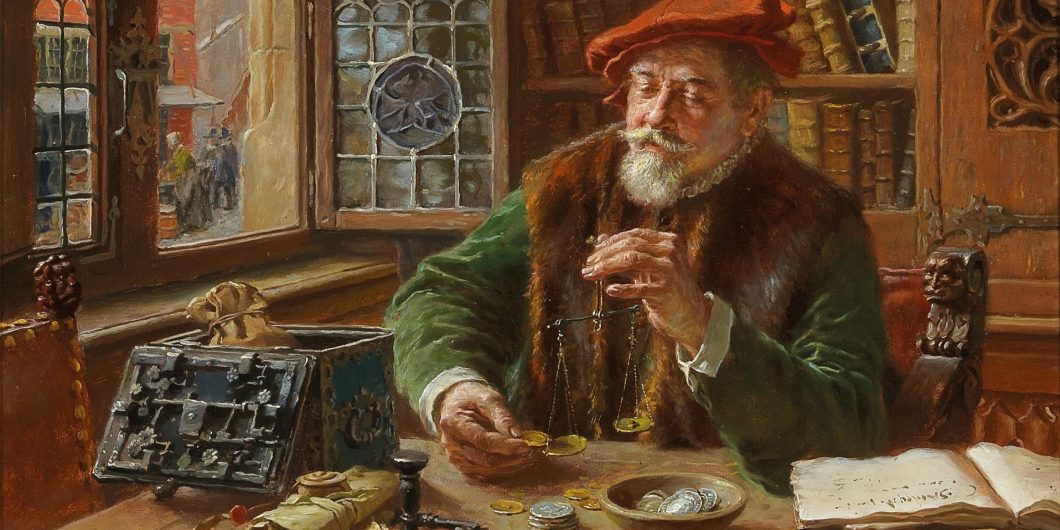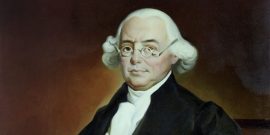James Wilson’s jurisprudence suffered multiple defeats, complicating the idea of an American natural law tradition.
"The Most Important Price of All"
In The Price of Time, Edward Chancellor has given us a colorful and provocative review of the history, theory, and profound effects of interest rates, the price that links the present and the future, which he argues is “the most important price of all.”
The history runs from Hammurabi’s Code, which in 1750 BC was “largely concerned with the regulation of interest,” and from the first debt cancellation (which was proclaimed by a ruler in ancient Mesopotamia) all the way to our world of pure fiat currencies, the recent Everything Bubble (now deflating), cryptocurrencies (now crashing), and the effective cancellation of government debt by inflation and negative interest rates.
The intellectual and political debates run from the Old Testament to Aristotle to John Locke and John Law, to Friedrich Hayek and John Maynard Keynes, to Xi Jinping and Ben Bernanke, and many others.
As for the vast effects of interest rates, a central theme of the book is that in recent years interest rates were held too low for too long, being kept “negative in real terms for years on end,” with resulting massive financial distortions for which central banks are culpable.
The Effects of Low Interest Rates
Chancellor chronicles how over the centuries, many writers and politicians have favored low interest rates. They have in mind an image of the Scrooge-like lender, always a usurer lending at excessive interest, grinding down the impoverished and desperate borrower—not unlike contemporary discussions of payday lending. For example, Chancellor quotes A Discourse Upon Usury, written by an Elizabethan judge in 1572, which describes the usurer as “hel unsaciable, the sea raging, a cur dog, a blind moul, a venomus spider, and a bottomless sacke…most abominable in the sight of God and man.” Presumably, the members of the American Bankers Association and of the Independent Community Bankers of America would object to this description.
In fact, the roles of lender and borrower have often been and are in large measure today the opposite of the traditional image. This was already clear to John Locke, as Chancellor shows us. The great philosopher turned his mind in 1691 to “Some Considerations of the Lowering of Interest Rates” and “saw many disadvantages arising from a forced reduction in borrowing costs” and lower interest rates paid to lenders. For who are these lenders? Wrote Locke: “It will be a loss to Widows, Orphans, and all those who have their Estates in Money”—just as it was a loss in 2022 to the British pension funds when these funds got themselves in trouble by trying to cope with excessively low interest rates. Moreover, who would benefit from lower interest rates? Locke considered that low interest rates “will mightily increase the advantages of bankers and scriveners, and other such expert brokers … It will be a gain to the borrowing merchant.” Lower interest rates, Chancellor adds, would also benefit “an indebted aristocracy.”
In Chancellor’s summary, “Locke was the first writer to consider at length the potential damage produced by taking interest rates below their natural level.” Locke’s position in modern language includes these points:
- Financiers would benefit at the expense of ”widows and orphans”
- Wealth would be redistributed from savers to borrowers
- Too much borrowing would take place
- Asset price inflation would make the rich richer
Just so, over our recent years of too-low interest rates, ordinary people have had the purchasing power of their savings expropriated by central bank policy and leveraged speculators of various stripes made large profits from overly cheap borrowing, while debt boomed and asset prices inflated into the Everything Bubble.
The central bankers knew what they were doing with respect to asset prices. Chancellor quotes a remarkably candid statement in a Federal Open Market Committee meeting in 2004, in which, as a Federal Reserve Governor clearly put it:
[Our] policy accommodation—and the expectation that it will persist—is distorting asset prices. Most of the distortion is deliberate and a desirable effect if the stance of policy. We have attempted to lower interest rates below long-term equilibrium rates and to boost asset prices in order to stimulate demand.
That boosting asset prices was “deliberate” is correct; that it was “desirable” seems mistaken to Chancellor and to me. “The records show that the Fed had used its considerable powers to boost the housing market,” he writes (I prefer the phrase, “stoke the housing bubble”). What is worse, the Fed did it twice, and we had two housing bubbles in the brief 23 years of this century. In 2021, the Fed was inexcusably buying mortgage securities and suppressing mortgage rates while the country was experiencing a runaway house price inflation (now deflating).
In general, “Wealth bubbles occur when the interest rate is held below its natural level,” Chancellor concludes.
“The setting of interest rates [by central banks] is just one aspect of central planning,” Chancellor observes.
Bad Press
On a different note, he mentions that suppression of interest rates could lead to “Keynes’ long-held ambition for the euthanasia of the rentier,” using Keynes’ own memorable, if unpleasant, phrase. The recent long period of nearly zero interest rates, however, led to huge market gains on the investments of the rentiers, and caused instead the euthanasia of the savers—or at least the robbing of the savers.
Our recent experience has shown again how borrowers may be made richer by low interest rates, as were speculators, private equity firms, and corporations that levered up with cheap debt. “It is clear that unconventional monetary policies…had a profound impact on inequality,” Chancellor writes, “the greatest beneficiaries from the Fed’s policies [of low interest rates] were the financial elite, who got to enhance their fortunes with cheap leverage at a time when asset values were driven higher by easy money.”
Historically there was a question of whether there should be interest charged at all. “Moneylenders have always received a bad press,” Chancellor reflects, “Over the centuries… the greatest minds have been aligned against them”—Aristotle, for example, thought charging interest was “of all modes of making money…the most unnatural.” The Old Testament restricted charging interest, but as Chancellor points out, the Book of Deuteronomy makes this important distinction: “You shall not lend upon interest to your brother, interest on money, interest on victuals, interest on anything,” but “To a foreigner you may lend upon interest.” This raises the question of who is my brother and who is a foreigner, but does seem to be an early acceptance of international banking. It also makes me think that anyone who has made loans from the Bank of Dad and Mom at the family interest rate of zero, will recognize the intuitive distinction expressed in Deuteronomy.
Needless to say, loans and investments bearing interest prevail around the globe in the tens of trillions of dollars, the moneylenders’ bad press notwithstanding. This is, at the most fundamental level, because interest rates reflect the reality of time, as Chancellor nicely explains. One thousand dollars ten years from now and one thousand dollars today are naturally and inescapably different, and the interest rate is the price of that difference, which gives us a precise measure of how different they are.
A perpetually intriguing part of that price is how interest compounds over long periods of time. “The problem of debt compounding at a geometrical rate has never lost its fascination,” Chancellor observes, and that is certainly true. “A penny put out to 5 percent compound interest at our Savior’s birth,” he quotes an 18th-century philosopher as calculating, “would by this time [in 1773]… have increased to more money than would be contained in 150 millions of globes, each equal to the earth in magnitude, all solid gold.”
The quip that compound interest is “the eighth wonder of the world” is often attributed to Albert Einstein, but Chancellor traces it to a more humble origin: “an advertisement for The Equity Savings and Loan Company published in the Cleveland Plain Dealer” in 1925. “Compound interest… does things to money,” the advertisement continued, “At the Equity it doubles your money every 14 years.” This meant the savings and loan’s deposits were paying 5% interest—the same interest rate used in the preceding 1773-year calculation, but that case represented 123 doublings.
The mirror image of sums remarkably increasing with compound interest is the present value calculation, which reduces the value of future sums by compound interest running backward to the present, a classic tool of finance. Just as we are fascinated, as the Equity Savings and Loan knew, by how much future sums can increase, depending on the interest rate that is compounding, so we are also fascinated by how much today’s market value of future sums can shrink, depending on the interest rate.
If the interest rate goes from 1% to 4%, about what the yield on the 10-year Treasury note did in 2021-2022, the value of $1,000 ten years from now drops from $905 to $676, or by 25%. You still expect exactly the same $1,000 at exactly the same time, but you find yourself 25% poorer in market value.
Central Bank Distortions
In old British novels, wealth is measured by annual income, as in “He has two thousand pounds a year.” One role of changing interest rates is to make the exact same investment income represent very different amounts of wealth. If interest rates are suppressed by the central banks, it makes you wealthier with the same investment income; if they are pushed up, it makes you poorer. If they change a lot in either direction, the change in wealth is a lot. The math is elementary, but it helps demonstrates why interest rates are, as Chancellor says, the most important price.
In the 21st century, “The Federal Reserve lowered interest rates to zero and sprayed money around Wall Street.” But if the interest rate is zero, $1,000 ten years in the future is worth the same as $1,000 today, a ridiculous conclusion, and why zero interest rates are only possible in a financial world ruled by central banks.
More egregious yet is the notion of negative interest rates, which were actually experienced on trillions of dollars of debt during the last decade. “The shift to negative interest rates comprised the central bankers’ most audacious move,” Chancellor writes. “What is a negative interest rate but a tax on capital—taxation without representation.” With negative interest rates, $1,000 ten years in the future is worth more than $1,000 today, an absurd conclusion, likewise proof that negative interest rates can only exist under the rule of central banks.
“The setting of interest rates [by central banks] is just one aspect of central planning,” Chancellor observes. In his ideal world, expressed on the book’s last page, “central banks would no longer be able to pursue an active monetary policy,” and “guided by the market’s invisible hand, the rate of interest would find its natural level.” Given all the mistakes central banks have made, with the accompanying distortions, this is an attractive vision, but unlikely, needless to say.


